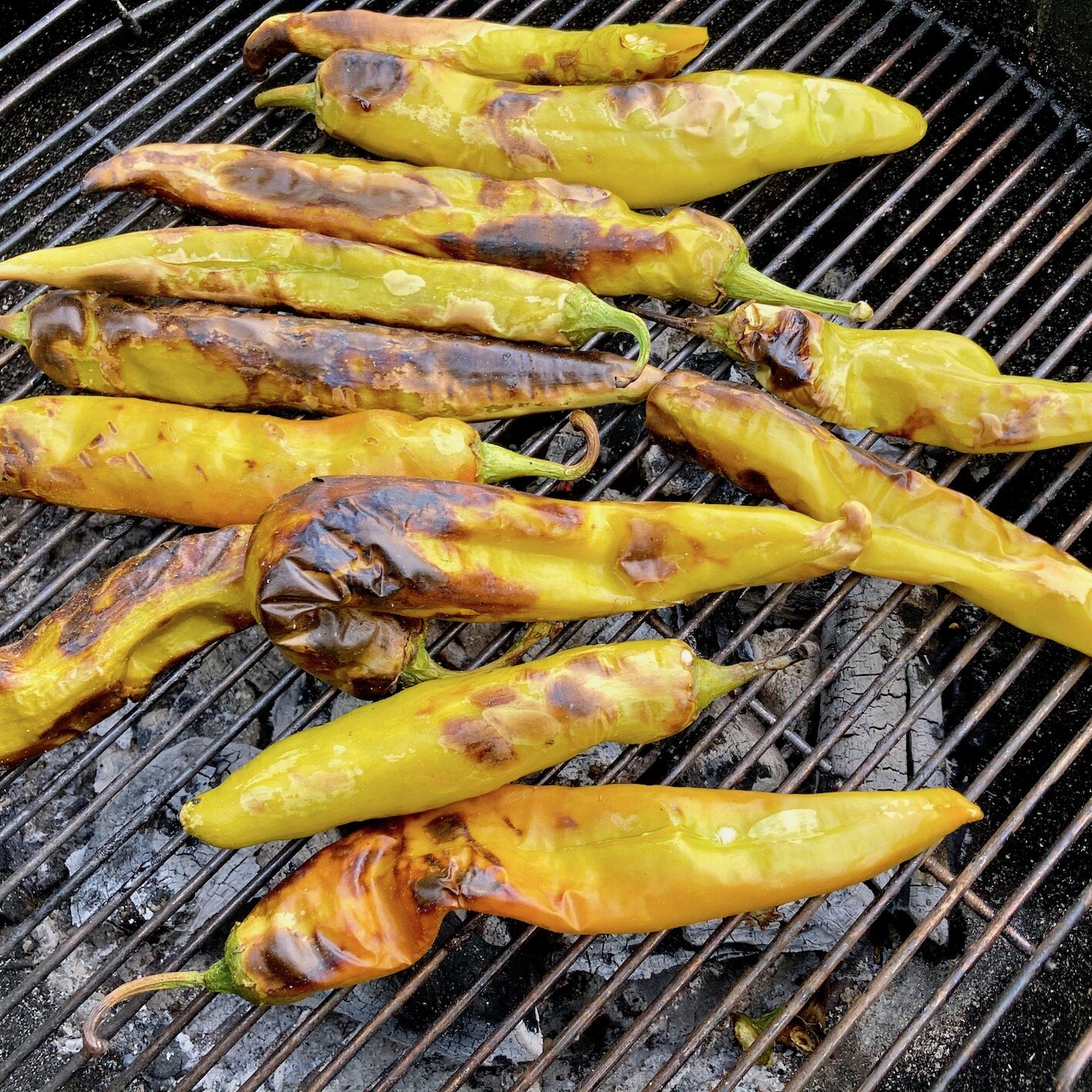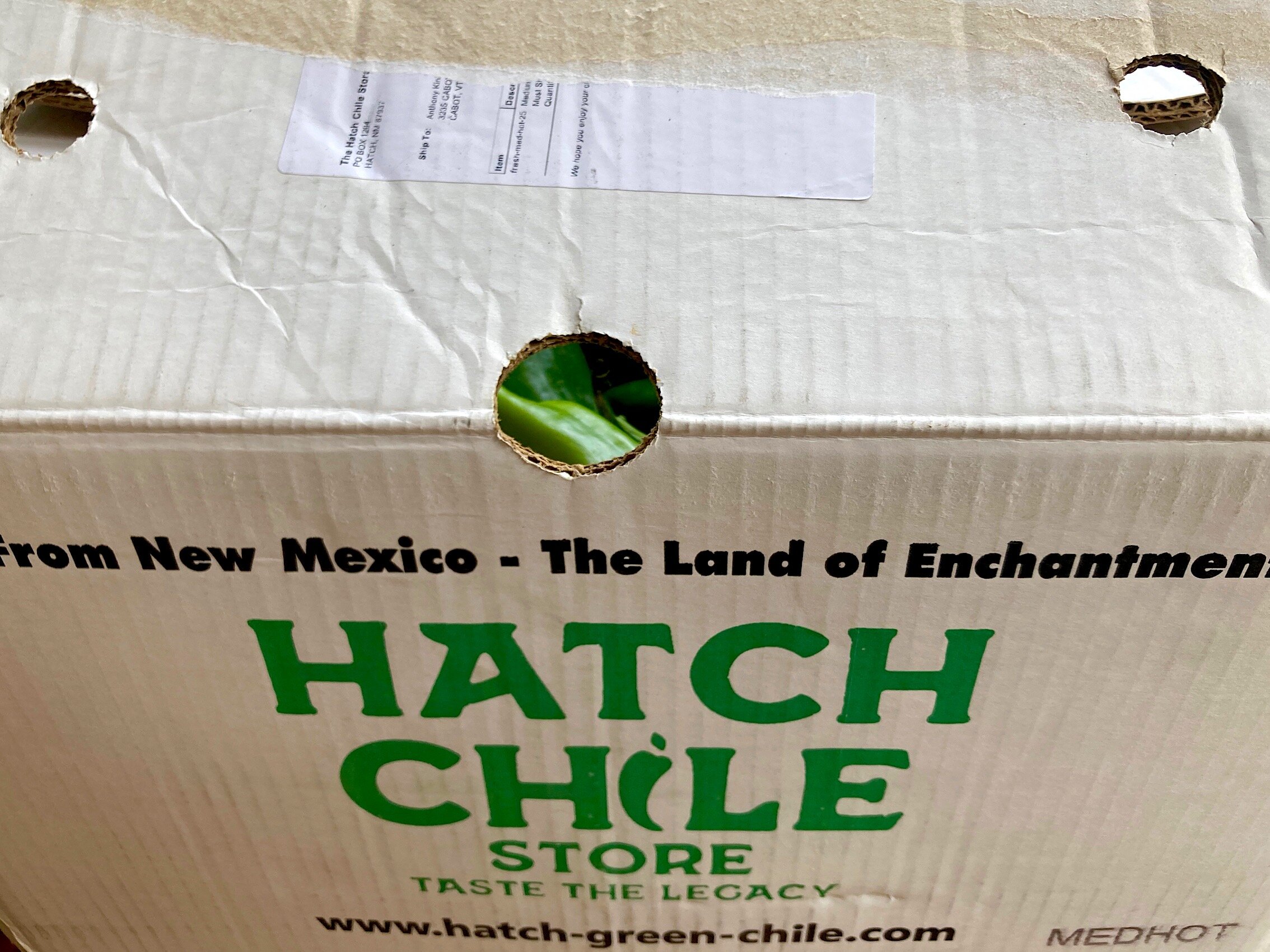fig. a: those other Chi Peps
Long-time readers of …an endless banquet will surely recall our deep, deep love for all things green chile. Actually, long-time friends of …an endless banquet might also be familiar with our [ed: well, Michelle’s, actually] deep, deep love of the Chi Peps—Los Angeles’s Red Hot Chili Peppers. But here I want to address those other Chi Peps: New Mexico’s Green Hot Chile Peppers.
Much of that love was first inspired by a game-changing trip I paid to the Land of Enchantment back in the 1990s. That was the first time I experienced the Cult of Green Chile full-on. I had it on eggs, in burritos, smothering home fries, on enchiladas, and in countless other ways, for breakfast, lunch, and dinner. The Green Chile Ritual never grew old for me, and I’ve never really shaken it.
fig. b: The Cult of Green Chile
In fact, I’ve been trying to replicate it, thousands of miles from New Mexico, for many years now without the benefit of the very peppers that are the essence of the Cult of Green Chile: genuine Hatch chiles. Not the ones that you can find in the little tin cans in supermarkets across America (although, god bless ‘em—those do come in handy sometimes), but the entire spectrum of green chiles (mild, medium, medium-hot, hot, and extra hot) that are famously grown in and around Hatch, NM—in the southern part of the state—versions of which have been a staple of the regional cuisine for centuries.
fig. c: fire-roasted green chiles
The preferred way of preparing these treasured peppers is to roast them over a fire—traditionally, a wood fire, but these days frequently a propane flame—peel them, seed them, and then make a salsa with them. This is the “green chile” that then appears in countless New Mexico specialties, from enchiladas to cheeseburgers, and everything in between.
In New Mexico, in the late summer and early fall, you can find makeshift chile roasting operations scattered all across the state, often in the parking lots of local supermarkets. Your chiles are roasted before your eyes in an oversized tumbler, and a minimum order is 20 pounds of peppers.
I’ve always wanted to visit New Mexico at this time of year to witness this spectacle with my own eyes—I mean, what better time to experience the Green Chile Ritual once again? I became even more fixated on this plan after reading David Tanis’s account of his visit to Hatch and environs at the height of Green Chile Season in Saveur a few years back. Initially 2020 seemed like it might be the year that would bring a return visit to New Mexico, just in time for the Hatch Green Chile Festival—just like Tanis—but then everything about this year changed quite drastically.
However, a few weeks ago, it occurred to me that if you can’t actually go to the festival, maybe you could try to bring the festival (or at least part of it) home. After all, fields had been planted. A crop was due to be harvested. So I did the logical thing and reached out to The Hatch Chile Store, and the next thing I knew I had 25 pounds of freshly picked peppers en route to me via express delivery.
The Hatch Chile Store offers a number of different peppers to choose from—from mild “1904” chiles to extra-hot “Lumbres”—but I opted for their Big Jims. Tanis describes this variety as, “large, fleshy, [and] moderately hot.” I’m not sure how Big Jim feels about that, but I knew this was a popular variety—one that’s got a reputation for being particularly meaty, and particularly easy to peel (win-win).
fig. d: “large, fleshy, [and] moderately hot”
Sure, you could order genuine Hatch chiles (including Big Jims) roasted, peeled, and seeded—either canned in jars, or frozen—but what would be the fun in that? I wanted to smell that “fire-roasted green spirit” Tanis had written about. Plus, I’ve always loved firing up the grill and roasting peppers for my improvised non-Hatch green chile concoctions—why wouldn’t I want to do the same with the real deal?
fig. e: peek-a-boo
That box of Big Jims showed on a Thursday afternoon. By that evening, I’d already roasted about twenty of those bad boys, made my first batch of genuine Hatch green Chile salsa, and used it to dress a smoked pork burrito. And by the following afternoon—using a battery of three BBQs—Michelle and I had roasted, peeled, and seeded the remaining 20+ pounds of peppers, and packed them in Ziploc bags to keep in the freezer.
fig. f: three grill day
The yield is far less than 25 pounds of green chile fillets and strips, of course—the stems, seeds, and peels all weigh something, and the peppers lose some moisture in the process of being roasted. But the chiles also gain a considerable amount of flavour in the process—and the result is simultaneously sweet, spicy, smoky, bitter, and herbaceous, and utterly addictive.
If ordering chiles online seems like too much of an ordeal (and an expenditure) for the taste of green chile, who knows? Maybe there’s someone in your locale who’s growing some actual New Mexico chiles and bringing them to market. If you happen to be in Montpelier, VT at this time of year, you can always drop by the farmers’ market and visit the LePage Farm stand. You might not find 25 pounds of Hatch peppers, but you will find a basket full.
And if not, as I’ve detailed elsewhere, you can make something approaching a New Mexico green chile salsa with other more readily available peppers: like Anaheims, Poblanos, Cubanelles, Serranos, and Jalapeños. At the very least, you can make use of the wonderful local onions and garlic that are so plentiful in so many parts of North America right now when you do.
Green Chile Salsa
1 medium onion (preferably sweet) chopped
1 tbsp olive oil
1 clove garlic, minced
1/2 cumin seeds, toasted and ground
fire-roasted green chiles
tomatillos (optional)
chicken broth or water
1 tsp masa harina
salt and pepper to taste
Sauté your onions in the olive oil until nice and soft. Add your chopped garlic and some toasted and ground cumin seeds. Add your roasted green chiles, some tomatillos, if you're using them, and your chicken broth. Be judicious with your use of liquid (chicken stock or water). You don't want to add too much, but the idea here is to add enough that you can cook your sauce down, uncovered, reducing it into a thing of beauty. This shouldn't take all that long. No more than about half an hour, if you've added the right proportion of broth/water. And keep in mind that if you’re using tomatillos, they will give off quite a bit of liquid. If you go that route (and it’s a wonderful path to take), it’s up to you to decide what your ratio of green chiles to tomatillos should be, but I would recommend about 3:1 (e.g., 1 1/2 cups of green chile strips and 1/2 cup of tomattilos). Any more and you’re really making a salsa verde, and not a green chile. Add a sprinkle of masa harina toward the end of this process if you'd like to thicken your sauce further and give it a bit of depth. The goal here is to create a fairly thick, chunky sauce that will be ideal for everything from dipping chips into to dressing a burger. And, like I said, it ought to taste like a thing of beauty, too.
This is another absolute classic, and one that was hugely inspired by a recipe from David Tanis’s A Platter of Figs And Other Recipes. Respect is due!
Green Chile Stew
5 pounds well-marbled boneless pork butt, cut into 2-inch cubes
salt and pepper
2 tbsp vegetable or olive oil
2 large onions, finely diced
4 to 6 garlic cloves, chopped
2 tsp cumin seeds, toasted and finely ground
1/2 cup chopped tomatillos, fresh or canned
6 large carrots, peeled and chunked
1 cup chopped roasted green chiles*
1 tbsp masa harina
8 cups water or chicken broth
chopped cilantro
hot corn or flour tortillas, to serve
Season the pork with salt and pepper. Heat the oil in a large Dutch oven or other heavy-bottomed pot. Add the meat, in several batches, without crowding, and brown it lightly. Transfer to a platter or tray.
Add the onions to the pot and brown them. Add the garlic, cumin, tomatillos, carrots, and green chiles, then sprinkle the masa harina over and stir. Salt the mixture, then return the browned meat to the pot and stir well. Cover with the broth and bring to a boil.
Cover the pot, turn the heat to low, and simmer gently for 2 to 3 hours—until the pork is tender and shreds easily.
Taste the broth and adjust it, adding salt or more green chile as necessary. The broth should be well seasoned and fairly spicy. Simmer for another 30 minutes or so, until the pork is exceedingly tender. Skim any fat from the surface of the broth.
Let the stew rest for an hour or more. Refrigerate overnight if desired (this allows the flavours to meld even more).
To serve, reheat the stew and ladle into warmed bowls. Sprinkle with chopped cilantro and accompany with hot tortillas.
Serves 8 to 10.
* Tanis notes that it takes about 12 large fresh chiles to produce 1 cup of chopped roasted chiles. It's preferable to grill them over an open fire, but you can also blacken them under the broiler or directly over a gas burner, in a pinch.
Green Chile Stew is quite literally a dish that makes people crazy. I’ve seen it happen. People go back for 3, 4, 5 helpings if you’re not careful. Be careful. You’re going to want some leftovers. Trust me.
aj



![fig. d: “large, fleshy, [and] moderately hot”](https://images.squarespace-cdn.com/content/v1/5407bbece4b0d617570ff0ed/1600222923680-AGNH71HXWWX9Q1JLOWG8/sea+of+green.jpeg)

